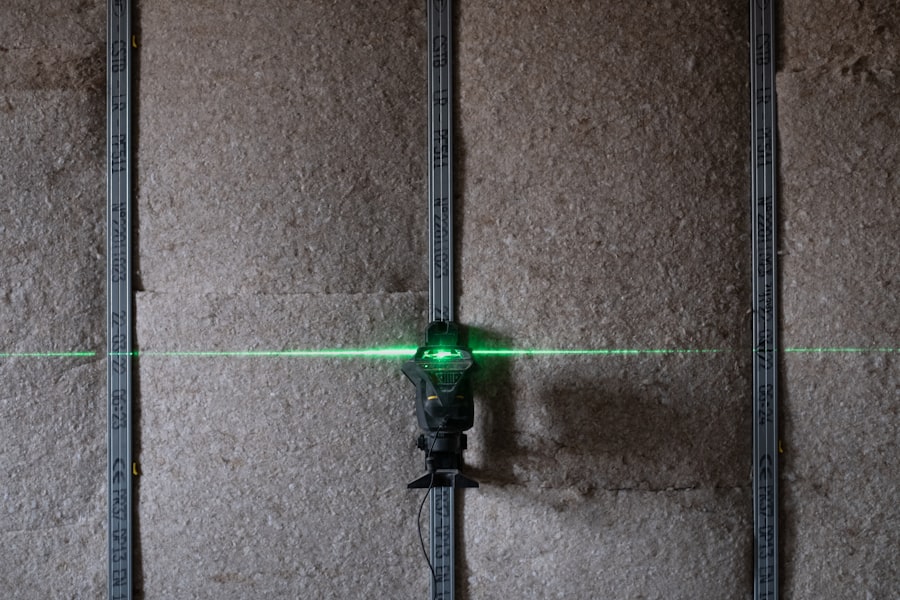Laser hair removal is a popular cosmetic procedure that utilizes concentrated beams of light to target and eliminate unwanted hair. The technology works by emitting a specific wavelength of light that is absorbed by the pigment in the hair follicles. This absorption generates heat, which damages the follicle and inhibits future hair growth.
As you consider this option, it’s essential to understand that laser hair removal is most effective on individuals with light skin and dark hair, as the contrast allows the laser to target the hair more effectively. The procedure is generally safe and can be performed on various body parts, including the face, legs, arms, and bikini area. However, it’s important to note that multiple sessions are usually required to achieve optimal results, as hair grows in different cycles.
You may find that some areas respond better than others, and patience is key. Understanding these fundamentals will help you set realistic expectations and prepare for your journey toward smoother skin.
Key Takeaways
- Laser hair removal uses concentrated light to target and destroy hair follicles, leading to long-term hair reduction.
- Before laser hair removal, it’s important to avoid sun exposure, waxing, and plucking to ensure the best results.
- When choosing an at-home laser hair removal device, consider factors such as skin tone, hair color, and the size of the treatment area.
- To maximize the effectiveness of your at-home laser hair removal device, follow the instructions carefully and be consistent with your treatments.
- After laser hair removal, it’s important to protect your skin from sun exposure and moisturize regularly to maintain smooth and healthy skin.
Preparing Your Skin for Laser Hair Removal
Consultation and Assessment
Begin by scheduling a consultation with a qualified practitioner who can assess your skin type and hair color.
Pre-Treatment Precautions
In the weeks leading up to your appointment, it’s advisable to avoid sun exposure and tanning beds. Tanned skin can increase the risk of side effects and may interfere with the laser’s ability to target hair follicles effectively.
Hair Removal Methods
Additionally, refrain from waxing or plucking hair in the treatment area for at least four weeks prior to your session, as these methods remove the hair from the follicle, which is necessary for the laser to work effectively. Instead, shaving is recommended, as it leaves the hair shaft intact while allowing the laser to target the follicle directly.
Choosing the Right At-Home Laser Hair Removal Device

With advancements in technology, at-home laser hair removal devices have become increasingly popular. When selecting a device, it’s essential to consider several factors to ensure you choose one that suits your needs. First, look for devices that have been clinically tested and approved by regulatory bodies.
This ensures that they meet safety standards and are effective for home use. Reading reviews and testimonials from other users can also provide valuable insights into a device’s performance. Another critical aspect to consider is your skin tone and hair color.
Many at-home devices are designed to work best on specific combinations of skin tones and hair colors. If you have light skin with dark hair, you’ll likely find more options available to you. Conversely, if you have darker skin or lighter hair, you may need to do additional research to find a device that is safe and effective for your unique combination.
Ultimately, investing time in choosing the right device will pay off in terms of both safety and results.
Tips for Using Your At-Home Laser Hair Removal Device
| Device Name | Recommended Areas | Sessions Needed | Skin Tone Compatibility |
|---|---|---|---|
| Laser Hair Removal Device A | Legs, Underarms, Bikini Line | 6-8 sessions | Fair to Medium |
| Laser Hair Removal Device B | Face, Arms, Chest | 8-10 sessions | Light to Medium |
| Laser Hair Removal Device C | Back, Stomach, Brazilian | 6-8 sessions | Fair to Dark |
Once you’ve selected an at-home laser hair removal device, it’s time to familiarize yourself with its operation. Start by reading the user manual thoroughly to understand how to use it safely and effectively. Most devices come with specific guidelines regarding treatment intervals and settings based on your skin tone and hair type.
Following these instructions closely will help you achieve optimal results while minimizing any potential risks. Before each session, ensure that your skin is clean and free from any lotions or creams that could interfere with the laser’s effectiveness. Shaving the treatment area a day or two before using the device can help enhance results by allowing the laser to focus on the hair follicles without obstruction.
During treatment, move the device slowly across your skin, ensuring that you cover all areas evenly. It’s also wise to start with a lower intensity setting if you’re new to laser hair removal, gradually increasing it as you become more comfortable with the process.
Maintaining Your Skin Post-Laser Hair Removal
After undergoing laser hair removal, proper post-treatment care is essential for maintaining healthy skin and optimizing results. Immediately following your session, you may notice some redness or swelling in the treated area; this is normal and should subside within a few hours. To soothe your skin, apply a cool compress or aloe vera gel to alleviate discomfort.
Avoid hot showers, saunas, or intense workouts for at least 24 hours post-treatment to prevent further irritation. In the days following your session, keep an eye on your skin’s condition. Moisturizing regularly can help maintain hydration and promote healing.
Additionally, it’s crucial to protect your skin from sun exposure during this time; applying a broad-spectrum sunscreen with an SPF of 30 or higher will shield your skin from harmful UV rays and prevent pigmentation changes. By taking these steps, you’ll not only enhance your results but also ensure that your skin remains healthy and radiant.
Managing Side Effects and Risks

While laser hair removal is generally considered safe, it’s important to be aware of potential side effects and risks associated with the procedure. Common side effects include temporary redness, swelling, or mild discomfort in the treated area. These symptoms typically resolve within a few hours or days but can vary depending on individual skin sensitivity.
If you experience persistent discomfort or any unusual reactions, it’s advisable to consult with a healthcare professional. In rare cases, more severe side effects can occur, such as blistering or changes in skin pigmentation. To minimize these risks, always follow pre- and post-treatment care instructions provided by your practitioner or device manufacturer.
Additionally, conducting a patch test on a small area of skin before full treatment can help gauge how your skin reacts to the laser.
Maximizing the Long-Term Results of Laser Hair Removal
To achieve long-lasting results from your laser hair removal treatments, consistency is key. Adhering to the recommended treatment schedule is crucial for targeting hair during its growth phase effectively. Most individuals require multiple sessions spaced several weeks apart to ensure that all hair follicles are treated adequately.
By committing to this schedule, you’ll maximize your chances of achieving smooth skin with minimal regrowth. In addition to regular treatments, maintaining a healthy skincare routine can further enhance your results. Incorporating gentle exfoliation into your regimen can help remove dead skin cells and prevent ingrown hairs from forming after treatment.
Furthermore, staying hydrated and eating a balanced diet rich in vitamins and minerals will support overall skin health. By combining these practices with your laser hair removal sessions, you’ll be well on your way to enjoying long-lasting smoothness.
When to Seek Professional Help
While at-home laser hair removal devices offer convenience and cost savings, there may be instances when seeking professional help is necessary or beneficial. If you experience persistent side effects or complications after using an at-home device, it’s crucial to consult with a dermatologist or licensed practitioner who specializes in laser treatments. They can assess your situation and provide tailored advice or alternative treatment options.
Additionally, if you find that at-home treatments are not yielding the desired results after several sessions, consider visiting a professional clinic for a consultation. Professionals often have access to more advanced technology and can customize treatments based on your specific needs. Ultimately, knowing when to seek expert guidance will ensure that you receive safe and effective care throughout your laser hair removal journey.
If you’re looking to get the best results with at-home laser hair removal, you may want to check out this article on how to properly prepare your skin for treatment. This article provides valuable tips on how to ensure your skin is in the best condition for effective hair removal. By following these guidelines, you can maximize the effectiveness of your at-home laser hair removal sessions and achieve smoother, hair-free skin.
FAQs
What is at-home laser hair removal?
At-home laser hair removal is a method of removing unwanted body hair using a handheld device that emits laser light to target and destroy hair follicles.
How does at-home laser hair removal work?
At-home laser hair removal works by emitting a concentrated beam of light that is absorbed by the pigment in the hair follicle. This damages the follicle and inhibits future hair growth.
Is at-home laser hair removal safe?
When used according to the manufacturer’s instructions, at-home laser hair removal is generally safe. However, it is important to perform a patch test and follow all safety precautions to avoid any adverse effects.
What are the benefits of at-home laser hair removal?
Some benefits of at-home laser hair removal include long-lasting hair reduction, convenience of use at home, and potential cost savings compared to professional treatments.
Are there any risks or side effects associated with at-home laser hair removal?
Possible risks and side effects of at-home laser hair removal may include skin irritation, redness, and in rare cases, burns or changes in skin pigmentation. It is important to follow safety guidelines and consult a healthcare professional if you have any concerns.
How can I get the best results with at-home laser hair removal?
To get the best results with at-home laser hair removal, it is important to choose the right device for your skin and hair type, follow the recommended treatment schedule, and properly prepare and care for your skin before and after each session.





